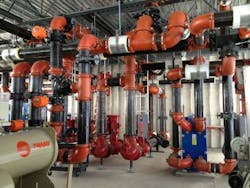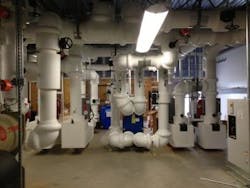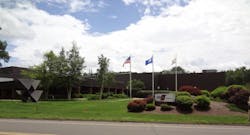2013 Design/Build Awards: 'Multi-tasking' Masterpiece
Designing for extensive industrial processes is perhaps the most demanding task in the mechanical HVAC world. Combine industrial processes with necessary comfort cooling, and you’ve got an extra-demanding project on your hands.
That was EMCOR Services New England Mechanical’s task, after it won the contract for the Orafol Americas facility in Avon, CT. The assignment: install a new central chilled water plant using R-123 centrifugal chillers, and a hydronic economizer to provide 300 nominal tons for a combination make-up air conditioning/comfort cooling system loop.
The New England Mechanical team completed this project — which also required a new controls system — in approximately one year’s time. Because of the intense amount of work it handled so admirably, this project has been awarded a Design/Build Award from ContractingBusiness.com.
The Best Kind of ‘Call-Back’
Orafol Americas Inc., (formerly Reflexite) manufactures reflective safety material for transportation/highway, military, construction, marine and recreational markets 24 hours a day, 7 days a week, only shutting down for a few holidays a year. The main manufacturing facility in Avon was soon to expand with the closing of a smaller site in July 2013, and a completion date was set for June.
Three Issues to be Addressed
The New England Mechanical team of Wayne Pare, Fred Manuel, Paul Gray, Russ Stevens, and Matthew Mullen were presented with three key challenges.
First, to cool rollers and process temperature control units, a single nominal 90-ton air-cooled chiller cooled a 30% propylene glycol/water loop serving the process chilled water load and two existing air handling units. However, the total connected chilled water flow rate was far beyond the nominal operating range for the existing chiller.
Second, a site survey found the building had a 25,550 CFM shortage of make-up air. It was being served by 25-year-old packaged rooftop units with outside air dampers set to a minimum position, except during economizer operation. The internal heat gain of the manufacturing space can become significant, which puts the system into constant cooling mode. It was evident that the existing packaged rooftop units had to be replaced.
Finally, noise from the existing screw air-cooled chiller serving the process loads was very loud; so loud, in fact, that it was causing neighbors to complain. The new process cooling system design would have to reduce the noise level.
The negative pressure and noise issued were discovered during discussions with the plant operations team. EMCOR Services New England Mechanical soon developed multiple options to address those issues, as well as the issue related to chilled water capacity. They furnished budget cost estimates, estimated operating costs, and an estimated life cycle costs analysis for each option.
The central chiller plant option— serving both process loads and comfort cooling through 100% outside air variable volume air handling units, providing the lowest life-cycle cost, was selected. The water cooled chilled water system and its cooling towers would also dramatically reduce the noise impact on the adjacent neighborhood.
The cooling towers were located in a well, away from the neighbors, with only the discharge of the cooling tower above the edge of the well. The design was reviewed by an acoustician, who confirmed the significant noise reduction benefits of our conceptual design.
A new central chilled water plantusing R-123 centrifugal chillers and a hydronic economizer provide 300 nominal tons, for a process cooling water system loop and 300 nominal tons for make-up air conditioning/comfort cooling system loop. During the heating season, the process chilled water system first rejects its heat to the process make-up air and then, if additional cooling is required, to the hydronic economizer.
Three new 92% efficient condensing boilerssupplement the make-up air system loop if the rejected process heat is insufficient to completely meet the make-up air heating requirements. The boilers also provide hot water for reheat in the new addition.
New 100% outside air, single zone variable volume air handling units totaling 64,000 CFM to provide make-up for process exhaust air, to maintain space pressurization, and to provide comfort cooling were installed in the new addition and to replace the original packaged rooftop units serving the existing manufacturing area. All new air handling units are connected to the new make-up air system piping loop.
Forward-thinking Foreman Saves Time
The project schedule originally showed the new mechanical room would be available for equipment installation starting in December 2012. The schedule also included a one-month system start-up in March 2013, which provided time for start-up, testing, and debugging before the cooling season arrived.
The foundation permit was issued in September 2012, however, unexpected soil conditions delayed the foundations for three months, which in-turn delayed the mechanical room availability until the last week in February 2013. “The delay meant our system start-up was now going to occur in late May or early June after the cooling season was in full gear,” says Dana Finnegan, president of EMCOR Services New England Mechanical.
“Fortunately, Project Foreman Fred Manuel began a constructability review, job planning, and a material take-off in the late fall of 2012. Like all great foreman, Fred ‘built the job in his head’ long before we installed our first piece of pipe or equipment,” Finnegan reports. “By the time the mechanical room was ready for us to begin our installation work, our crews were able to expedite our work due to Fred’s pre-planning. The pre-planning enabled mechanical construction to be completed faster than originally planned and we were ready to start testing our systems by early May.
“Unfortunately,” Finnegan continues, “permanent power wasn’t ready until the first week in June. Regardless of the late power availability, we were able to test the plant, get it operational, and successfully cut-over the existing process loads by the middle of June, 2013.”
Independent studies by an industrial hygienist documented the original manufacturing area had approximately 26,000 CFM more exhaust than make-up air. The severe negative pressure caused infiltration of particulate, insects, and humidity that created production defects and quality control problems impacting manufacturing throughout.
The new air handling systems are designed to maintain a proper space pressurization in response to a varying process exhaust rate which will solve the negative pressure problems and the resultant quality control problems The new make-up air systems are also designed to be predominately 100% outside air units and will only recirculate air within the manufacturing area when air circulation rates required for comfort cooling exceed the make-up air airflow rates.
This project was designed and installed according to ASHRAE Standard 90.1-201. Total installation cost was $2,643,000, with $2.1 million for process systems, and the remainder for the expansion of the HVAC system.
Controls: Delta/BACnet
The new Delta Controls Open Real-time Control Architecture (ORCA) is a native BACnet system. The ORCAview front end operator workstation software and the ORCAweb PC based web server software enables access to the entire system from any computer or smart phone. Both the Owner and EMCOR Services New England Mechanical can remotely monitor and adjust the system from any internet based device. The system uses BACnet interfaces to communicate directly with both the Trane centrifugal chillers and the Viessmann boiler controllers.
Utility Incentives Applied
Upon its completion, the project was submitted for utility incentives. The utility incentive process includes a peer review of the design and energy savings calculations. The local utilities provided a $717,000 incentive for the proposed design, when compared to a more conventional design that merely expanded the existing air cooled chiller system and new packaged equipment.
The success of this project is clear: EMCOR Services New England Mechanical delivered a solution that tripled the size of the process chilled water system, eliminated the negative pressure problems in the building, and addressed noise issues voiced by neighbors. The team overcame unforeseen schedule delays, secured a large utility incentive, and coordinated with the site expansion work, to minimize the capital expenditure and keep their process energy costs virtually unchanged.
All-in-all, it was a unique, Design/Build Award-quality solution to meet all of Orafol America’s requirements.



